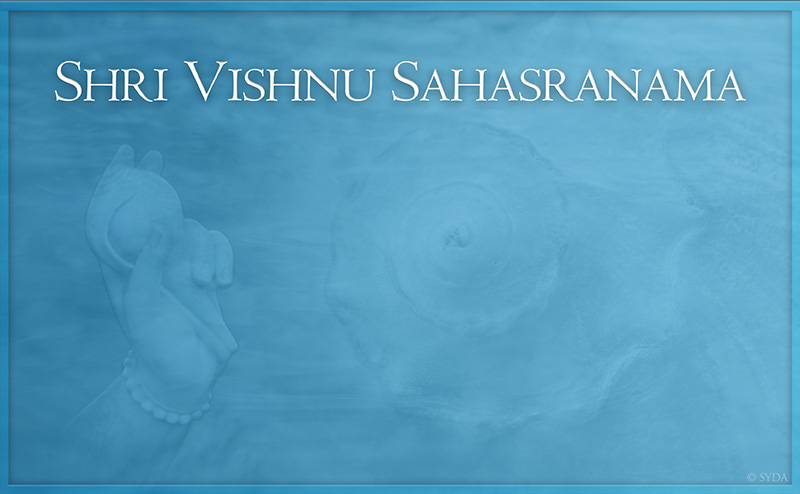Svadhyaya: The Recitation of Scriptural Texts

The Thousand Names of Lord Vishnu
Introduction by Elizabeth Grimbergen
Shri Vishnu Sahasranama—“The Thousand Names of Lord Vishnu”—is a Sanskrit stotra, a poetic hymn, honoring Lord Vishnu, each divine name a flower on an elegantly composed lyrical garland. When reciting Shri Vishnu Sahasranama, I find myself immersed in the nectar of one blossom after another until my being is completely suffused with a radiant and blissful energy. In the tradition of svadhyaya, which encourages both the recitation and the study of sacred texts, I enrich my experience by frequently studying and reflecting on the meaning of each name and its place within the hymn.
Baba Muktananda introduced his students to the regular recitation of sacred texts as part of svadhyaya. We will be able to practice reciting one of these, Shri Vishnu Sahasranama, with a recording made by the musical ensemble in Gurudev Siddha Peeth, the Siddha Yoga Ashram in India.
In 1967, Baba made this text part of the Ashram Daily Schedule at Gurudev Siddha Peeth. For many years, until January 2006, Shri Vishnu Sahasranama was recited after lunch as the afternoon svadhyaya. Honoring this tradition, in 2019 Gurumayi established the recitation of this sacred text on Saturday mornings in Shree Muktananda Ashram and Gurudev Siddha Peeth.
Lord Vishnu, whose name means “all-pervading,” is understood to be the ultimate Reality that creates, protects, and sustains the universe. In the introduction to the hymn, Lord Vishnu is described as “the supreme great light,” “the supreme great Brahman,” and “the supreme goal.”1 As sustainer of the universe, Lord Vishnu is said to take embodied form to restore cosmic order whenever the universe is threatened by chaos and destruction. Lord Krishna and Lord Rama are two of his most beloved and well-known avatars, divine incarnations.
Sahasranama, “a thousand names,” is a poetic genre of Indian devotional literature, intended to be sung in its lyrical meter and rhythm. Composed in the Sanskrit anushtup meter, Shri Vishnu Sahasranama contains, then, one thousand attributes expressed as names of Lord Vishnu. Each name is a unique facet or manifestation that expresses his divine nature, conveying in this way the truth that Supreme Reality is both one and simultaneously comprises infinite manifestations.
Each verse… indeed, each name, is worthy of reflection and study. Each name is a gateway into the infinitely rich and varied nature of Lord Vishnu. In my study of this text, I encountered several references to the story of Lord Vishnu’s third incarnation as Varaha, the Boar. With his gigantic tusks, Varaha reaches below the waters of the universal flood to rescue Bhumi, Earth. Cradled in his tusks, Earth is freed and set into her place as a way to restore order to the universe. In the hymn, several names refer to this incarnation: Mahavaraha (Great Boar), Mahibharta (Protector of Earth), and Vishakapih (Boar That Restores Dharma). As I reflected on these names, I came to the realization that no matter how dire the circumstance, God is always present to protect and uplift not only his devotees but the very universe itself, and he does so in the most amazing, creative, and profound ways.
Baba Muktananda loved Shri Vishnu Sahasranama, describing it as “the universal truth.”2 Baba continues by saying “Om is Vishnu. He is the pure, noble Soul, the paramatman. He is the final destination of all liberated beings. He is indestructible. He is the supreme witness that is conscious of all that is happening in the universe and in the mind. He is yoga.”3
Shri Vishnu Sahasranama is found within the Anushasana Parva, the thirteenth book of the ancient Indian epic, the Mahabharata. The Mahabharata describes the massive battle in which the Pandava brothers defeat their cousins, the Kauravas, to restore dharma and return the Kuru kingdom to its rightful rulers. Following the battle, Yudhishthira, the eldest of the Pandavas, approaches Bhishma, the greatest warrior and statesman of the Kauravas, for advice on how to rule. Bhishma, now lying on a bed of arrows awaiting death, obliges Yudhishthira by providing a wealth of instructions on the dharma of a ruler. These instructions form the Anushasana Parva.
In chapter 134, Yudhishthira asks Bhishma: “What is the sole divinity in the world? In other words, what is the one supreme goal? By praising whom, by worshipping whom, can men obtain the good?”4 Bhishma responds: “The Lord of the world, the God of gods, the Infinite, the supreme Person—by praising him constantly by means of his thousand names, a person is always uplifted.”5
Recited with discipline and focus, Shri Vishnu Sahasranama purifies the heart and the mind through the sound of its divine mantras, which ultimately leads to the recognition of the unity of one’s own Self with the principle that pervades and sustains all in this creation, Lord Vishnu.
2 Swami Muktananda, “Vishnu Sahasranam,” in Swami Muktananda: American Tour 1970 (Piedmont, CA: Shree Gurudev Siddha Yoga Ashram, 1974), p. 64.
3 Swami Muktananda, “Vishnu Sahasranam,” p. 67.
4 The Nectar of Chanting, p. 74.
5 The Nectar of Chanting, p. 74.

